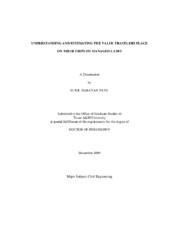| dc.contributor.advisor | BURRIS, MARK W. | |
| dc.creator | Patil, Sunil N. | |
| dc.date.accessioned | 2011-02-22T22:23:49Z | |
| dc.date.accessioned | 2011-02-22T23:45:56Z | |
| dc.date.available | 2011-02-22T22:23:49Z | |
| dc.date.available | 2011-02-22T23:45:56Z | |
| dc.date.created | 2009-12 | |
| dc.date.issued | 2011-02-22 | |
| dc.date.submitted | December 2009 | |
| dc.identifier.uri | https://hdl.handle.net/1969.1/ETD-TAMU-2009-12-7378 | |
| dc.description.abstract | Travelers' value of travel time savings (VTTS) are often used to estimate the
benefits of transportation facilities, including managed lanes (MLs). With various
eligibility criteria and time of day pricing on the MLs, the VTTS estimation is
complicated. This is evident by the underestimation of VTTS on MLs in many of the
previous studies. This study investigates stated preference (SP) survey design strategies
and differentiating the VTTS for ordinary and some common urgent situations faced by
the travelers in an attempt to improve on VTTS estimation on MLs.
This study used three different survey design strategies (including a D-efficient
design) in an internet based survey of Katy Freeway travelers. It was found that a
random attribute level generation strategy, where the VTTS presented in the alternative
was adjusted based on the answer to a previous SP question, performs better than the
other two designs with respect to VTTS estimation and other survey design efficiency
criteria.
The analysis to differentiate the VTTS for ordinary and urgent trips was carried
out using the state of art in the mixed logit model estimation. It was found that travelers
value their travel time savings much more when facing most of these urgent situations
rather than ordinary situations. Both peak and off-peak period travelers' VTTS were also found to be significantly greater when on urgent trips. Survey design attribute level
ranges were found to significantly affect the VTTS estimation.
Further, in order to understand the policy implications of these findings it was
demonstrated that classifying all trips as ordinary can significantly underestimate the
VTTS benefits offered by the MLs. Additionally, the VTTS of any urgent trips would be
greatly underestimated. The study also demonstrated that many of the low and medium
income group travelers on urgent trips can have VTTS greater than that of the highest
VTTS traveler from the high income group on an ordinary trip. These findings have
significant policy implications since the benefits of MLs (and of most transportation
investments) are primarily derived from travel time savings. Underestimating the VTTS
and hence the benefits for MLs can result in reducing the likelihood of funding such
facilities. This study provides an important first step in the proper estimation of these
benefits by suggesting modifications to SP surveys to better capture the influence of
urgent trips on the value of a ML facility. | en |
| dc.format.mimetype | application/pdf | |
| dc.language.iso | en_US | |
| dc.subject | HOT lanes | en |
| dc.subject | Managed Lanes | en |
| dc.subject | Value of Travel Time Savings | en |
| dc.subject | Mixed Logit Model | en |
| dc.subject | Survey Design | en |
| dc.subject | D-efficiency | en |
| dc.title | Understanding and Estimating the Value Travelers Place on Their Trips on Managed Lanes | en |
| dc.type | Book | en |
| dc.type | Thesis | en |
| thesis.degree.department | Civil Engineering | en |
| thesis.degree.discipline | Civil Engineering | en |
| thesis.degree.grantor | Texas A&M University | en |
| thesis.degree.name | Doctor of Philosophy | en |
| thesis.degree.level | Doctoral | en |
| dc.contributor.committeeMember | SHAW, WILLIAM D. | |
| dc.contributor.committeeMember | SHERMAN, MICHAEL | |
| dc.contributor.committeeMember | ZHANG, YUNLONG | |
| dc.type.genre | Electronic Dissertation | en |
| dc.type.material | text | en |


